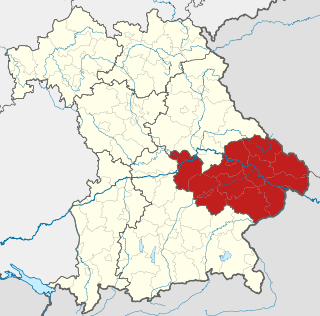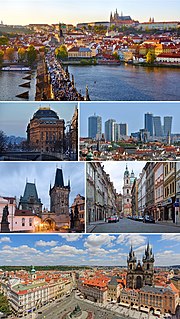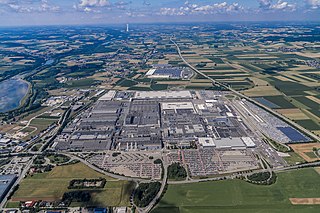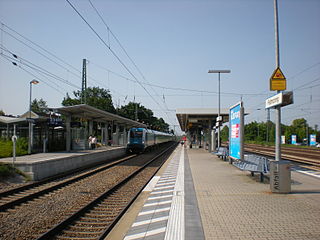
Feldmoching is a station in the Feldmoching section of Munich District 24, Feldmoching-Hasenbergl. Two rail lines serve the station, S-Bahn line S 1 and U-Bahn line U 2.

München Moosach station is a station in the Moosach district of Munich, the capital of the German state of Bavaria. It consists of an above-ground station for regional and Munich S-Bahn services and an underground station for the Munich U-Bahn.
The Royal Bavarian Eastern Railway Company or Bavarian Ostbahn was founded in 1856. Within just two decades it built an extensive railway network in the eastern Bavarian provinces of Upper Palatinate (Oberpfalz) and Lower Bavaria (Niederbayern) that had previously been largely undisturbed by the railway. Much of this network is still important for local and long distance rail traffic operated by the Deutsche Bahn today.

The Bundesautobahn 92 connects Munich with Deggendorf, and is 134 kilometres long. Between the interchange Neufahrn and the interchange Munich Airport it has three lanes, otherwise two with a shoulder. There is a traffic control system in the direction of Deggendorf until right before the exit to the airport.
The building of the Zwiesel–Grafenau railway, today route number 906 in the timetable, was begun in 1884 by the Royal Bavarian State Railways and taken into service on 1 September 1890. With a total length of 32 km it linked the towns of Zwiesel and Grafenau in the Bavarian Forest. At Zwiesel railway station it connects to the Bavarian Forest railway from Plattling to Bayerisch Eisenstein, built by the Bavarian Ostbahn and opened on 16 September 1877, as well as the line to Bodenmais opened on 3 September 1928.
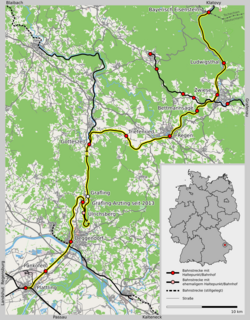
The Bavarian Forest Railway links the heart of the Bavarian Forest around Regen and Zwiesel to Plattling and the Danube valley on one side, and the Czech Republic through Bayerisch Eisenstein on the other. In the Danube valley it forms a junction with the Nuremberg–Regensburg–Passau long distance railway and, to the south, regional lines to Landshut and Munich.

The Passau–Freyung railway, also known as the Ilz Valley Railway or Ilztalbahn, is a branch line in Bavaria, Germany. It runs from Passau to the town of Freyung in the Bavarian Forest. At Kalteneck it forms a junction with the branch line to Eging-Deggendorf. At Waldkirchen the Waldkirchen–Haidmühle line branches off towards the Czech border, where since 1945 there has been a junction with the Czech railway network.

The Mühldorf–Pilsting railway runs mainly through the province of Lower Bavaria in Germany, but part of the line crosses into Upper Bavaria as well. It was opened in 1875 by the Bavarian Eastern Railway Company as part of the route between Mühldorf and Plattling, and was taken over by the Royal Bavarian State Railways on 1 January 1876. Whilst the southern section of the route from Mühldorf to Neumarkt-Sankt Veit became an important regional transport link as a result of the branches to Landshut and Passau at Neumarkt-Sankt Veit, the remaining section of the line never achieved its expected significance. Since 1970 only goods trains have worked between Neumarkt-Sankt Veit and Frontenhausen-Marklkofen, the adjoining section to Pilsting was closed entirely in 1969.

The Neumarkt-Sankt Veit–Landshut railway is a single-tracked, unelectrified main line in Bavaria in southern Germany. It is operated by SüdostBayernBahn.
SüdostBayernBahn is one of several regional railway networks in Germany owned by Germany's national railway, Deutsche Bahn AG. Since 2001, the network has included the railway hub of Mühldorf which connects 7 major railway lines from Munich, Rosenheim, Freilassing, Burghausen, Simbach am Inn, Passau and Landshut, forming a star-shaped network of lines called Linienstern Mühldorf. SüdostBayernBahn is subordinated to DB RegioNetz Verkehr and DB RegioNetz Infrastruktur.
The Regensburg–Passau railway forms a key transport link from Germany to Austria and other southeast European countries and is one of the most important main lines in southern Germany. It is double-tracked and electrified throughout.
The Deggendorf–Plattling Railway company was an early German railway company founded in 1865 with an original capital of 300,000 gulden and established to build a railway line between Deggendorf and Plattling in Bavaria, southern Germany. The capital was divided into 3,000 shares of 100 gulden each.

Plattling station is a central railway hub in eastern Lower Bavaria in southern Germany.
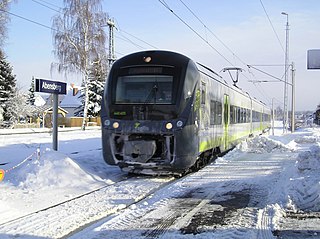
The Danube Valley Railway in Bavaria in southern Germany is the railway line that runs from Regensburg via Ingolstadt and Donauwörth to Ulm, just over the Bavarian border in Baden-Württemberg.
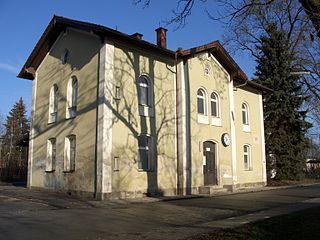
The Wallersdorf–Münchshofen railway was a metre gauge railway in the province of Lower Bavaria in southern Germany. It was operated from 1926 to the end of 1949 by the Wallersdorf and Country Narrow-Gauge Railway Cooperative whose head office was in Büchling. The line started from the station in the market town of Wallersdorf, in Dingolfing-Landau district, and ran to Münchshöfen in the municipality of Oberschneiding, in Straubing-Bogen district. The railway was exclusively used by goods trains.

The Munich–Regensburg railway is a double track, electrified main line railway, linking Munich and Regensburg in the German state of Bavaria, with a total length of 138.1 km. It was opened in 1858 and 1859 and is one of the oldest railways in Germany.

The Neufahrn–Radldorf railway is a single-track, non-electrified branch line from Neufahrn along the Kleine Laber to Radldorf in Lower Bavaria. It was opened in 1859 and is one of the oldest railways in Germany.

Landshut (Bayern) Hauptbahnhof is the main railway station in Landshut in the German State of Bavaria. There is also the halt (Haltepunkt) of Landshut (Bay) Süd on the Neumarkt-Sankt Veit – Landshut railway. The Hauptbahnhof has seven platforms tracks and is classified by Deutsche Bahn as a category 2 station. It is used daily by about 120 trains operated by DB Regio, Regentalbahn and Agilis. Landshut is on the Munich–Regensburg, Munich–Landshut–Passau and Landshut–Mühldorf lines. In addition, the station is located on the Landshut Neuhausen museum line.

Mühldorf (Oberbayern) station is a railway junction and station in the district town of Mühldorf in the German state of Bavaria. The station has seven platform tracks and is classified by Deutsche Bahn as a category 4 station. The station is served by 105 passenger trains each day operated by the Südostbayernbahn and frequented by about 10,000 travellers. It is also the central station of the “Bavarian Chemical Triangle”. About 800 freight wagons are dispatched from it daily.
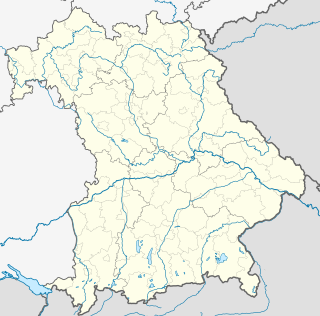
Freising station is located in the town of Freising in the German state of Bavaria. It is located a few hundred metres to the south of the Domberg on the southern edge of the old town.

